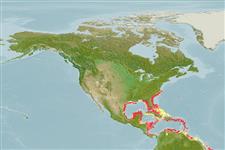Axinella polycapella de Laubenfels, 1953
| Native range | All suitable habitat | Point map | Year 2050 |

|
| This map was computer-generated and has not yet been reviewed. |
| Axinella polycapella AquaMaps Data sources: GBIF OBIS |
Upload your photos
Google image |
No photo available for this species.No drawings available for Axinellidae.
Google image |
No photo available for this species.
Classification / Names Common names | Synonyms | CoL | ITIS | WoRMS
Demospongiae | Axinellida | Axinellidae
Environment: milieu / climate zone / depth range / distribution range Ecology
Sessile; depth range 12 - 44 m (Ref. 108813). Tropical
Distribution Countries | FAO areas | Ecosystems | Occurrences | Introductions
Western Central Atlantic.
Length at first maturity / Size / Weight / Age
Maturity: Lm ? range ? - ? cm
Short description Morphology
Central column attached with flexible erect branches, sometimes whip-like. Branch tips may be pointed, rounded, or dichotomous; sometimes jointed. Smooth to velvet surface pierced by small pores less than 1 mm in diameter. Star-shaped oscules present. Orange red or bright red in situ; purple, tan, light to dark brown or combination of light and dark brown in alcohol.
Life cycle and mating behavior Maturity | Reproduction | Spawning | Eggs | Fecundity | Larvae
Members of the class Demospongiae are hermaphroditic. Life cycle: The zygote develops into parenchymella larva (free-swimming) before settling down on a substrate where it grows into a young sponge.
Main reference
References | Coordinator | Collaborators
Alvarez, B., R.W.M. van Soest and K. Rützler. 1998. (Ref. 81712)
IUCN Red List Status (Ref. 130435: Version 2024-1)
CITES status (Ref. 108899)
Not Evaluated
CMS (Ref. 116361)
Not Evaluated
Threat to humans
Human uses
Fisheries: commercial
| FishSource |
Tools
More information
Trophic Ecology
Food items
Diet
Food consumption
Ration
Predators
Diet
Food consumption
Ration
Predators
Ecology
Population dynamics
Growth
Age/Size
Length-weight
Length-length
Length-frequencies
Mass conversion
Recruitment
Abundance
Age/Size
Length-weight
Length-length
Length-frequencies
Mass conversion
Recruitment
Abundance
Life cycle
Distribution
Human Related
Aquaculture profile
Stamps, Coins Misc.
Stamps, Coins Misc.
Outreach
References
Internet sources
BHL | BOLD Systems | CISTI | DiscoverLife | FAO(Publication : search) | Fishipedia | GenBank (genome, nucleotide) | GloBI | Gomexsi | Google Books | Google Scholar | Google | PubMed | Tree of Life | Wikipedia (Go, Search) | Zoological Record
Estimates based on models
Preferred temperature
(Ref. 115969): 24.4 - 28, mean 26.5 (based on 52 cells).
Price category
(Ref. 80766):
Unknown.


